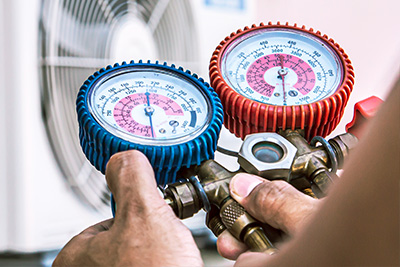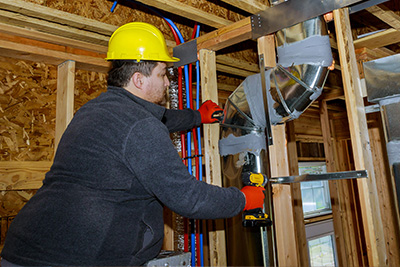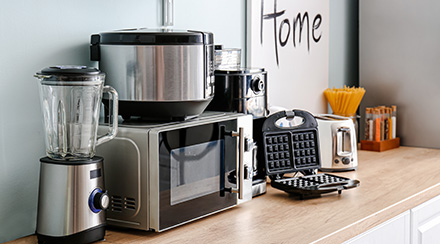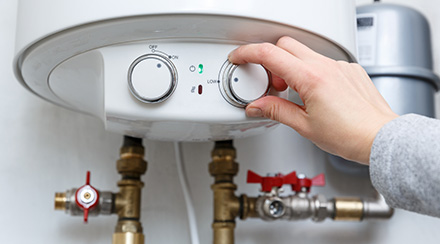Tips for Improving Your AC and Furnace Efficiency
In most U.S. homes, space heating and cooling account for about half of all energy consumption. With such a large share of our energy dollars going toward keeping our homes comfortable, it makes sense to think carefully about how to make your air conditioner and furnace more efficient.
These tips will help you ensure energy-efficient operation of your heating and cooling systems, as well as improve your home so you can use those systems less.

For Air Conditioner and Furnace Efficiency, Annual Maintenance Is Key
Central air conditioners, gas furnaces and electric furnaces should be maintained at least once a year by a licensed HVAC professional. This tune-up service should include a thorough cleaning, detailed inspection, coolant top-off, lubrication and other preventative maintenance steps. Having your system inspected by a trained eye once a year can help you catch problems early, before they escalate into more expensive issues.
Annual service will help maintain the efficiency of your systems, though it’s normal for heating and cooling equipment to gradually lose efficiency over time. So when your systems are starting to get close to their usual replacement intervals – 10 to 15 years for a central air conditioner and 20 to 30 years for a furnace – you should talk to your HVAC technician about the condition of your equipment when you have maintenance performed. You can also track your utility bills over time to look for increases in energy costs, which could be due to aging systems.
Timely Replacement of Air Conditioners and Furnaces
After many years of service, the dwindling efficiency of furnaces and air conditioners can make a real impact on your utility bills. While it makes sense to replace parts as needed on systems that have a lot of life left in them, you should plan ahead to replace your entire system when it gets old enough. If you wait until your aging system starts costing you serious money in energy costs, ordinary maintenance won’t help.
When shopping for a replacement system, be sure to look at efficiency ratings. Air conditioner efficiency is measured by the Seasonal Energy Efficiency Ratio, or SEER, and furnace efficiency is measured by the Average Fuel Utilization Efficiency, or AFUE. With both ratings, the higher the number, the more efficient the system. You can also look for the yellow and black EnergyGuide label on these appliances, which gives more detailed information about average energy costs.
Energy Saving Tips for Ducted Systems

As long as you schedule annual maintenance, keeping your central air conditioner and furnace running is a relatively easy job. But getting the best efficiency out of these ducted systems can take a little extra work. Follow these tips to make sure you’re saving energy while staying comfortable:
- Change your filter on schedule. Many disposable filters are designed to last for one month, though some higher-quality filters will last for three months. There are also reusable filters that should be removed and cleaned about once a month. Whatever filter you choose, make sure you stick to the recommended replacement or cleaning interval to ensure proper airflow, which is essential to energy efficiency.
- Keep your outdoor AC condenser free of debris. Tall grass, leaves, windblown objects and other obstructions can choke off airflow at your AC condenser. Whenever you see an obstruction, remove it to help your system breathe easy.
- Clean your vents. Accumulated dust not only inhibits airflow, it circulates around your home. During routine cleaning, always give your vents a quick once-over.
- Ensure airflow around vents. Whether they’re installed on your floors, ceilings or walls, HVAC vents should be unobstructed by furniture, rugs, hanging pictures or other objects.
- Find and seal leaky ducts. Gaps in your ductwork equal energy loss. Inspect any exposed ductwork and, if you find a leak, patch it with aluminum foil tape. If you have leaky ductwork in inaccessible areas, you can find HVAC professionals with the technology to seal these leaks from the inside.
- Insulate ductwork. You may be able to reduce efficiency loss even further by adding insulation to the outside of accessible ductwork.
Energy Efficiency of Other Air Conditioning Systems
Central air conditioners bring comfort and convenience to many homes, but in some spaces, it makes more sense to use window air conditioners or mini-split systems. These units require even less maintenance than central air systems, and they have their own best practices for energy efficiency:
- Make sure your equipment is the right size for your space. Mini-split systems, which require professional installation, should be sized by the experts. Window units, which are measured in size by BTUs, should have about 20 BTUs for every square foot of space they’re intended to cool.
- Clean or replace the filters per the maintenance schedule recommended by the manufacturer.
- Set the thermostat as high as comfortably possible, and keep the fan setting on "high" unless it is very humid. In humid conditions, use the "low" fan setting to help the unit remove more moisture from the air.
- Use pedestal fans if needed to help move cool air near the air conditioner to warmer areas of your home.
A Few More Energy Efficiency Tips
These tips don’t deal directly with the efficiency of your heating and air conditioning equipment, but they’ll help you stay comfortable while using your systems less often:
- Install a smart thermostat. Smart thermostats communicate with your heating and cooling equipment just like traditional thermostats do. These latest-generation thermostats can be controlled from anywhere with a smartphone, and they make it easier than ever to create customized heating and cooling schedules. Some models can even “learn” your habits and adjust automatically to save you money.
- Use window treatments wisely. In cold weather, let the sunlight stream in through your windows for a little free heat. In warm weather, use insulated shades or heavy drapes to block out that unwanted heat during the warmest hours of the day.
- Seal your home envelope. Search for drafts and seal them off using caulk, spray foam or new weather stripping. If you need help, schedule a professional home energy audit to locate air leaks you might not find otherwise.
- Use ceiling fans. In summer, they should spin counterclockwise to create a cooling downdraft. In winter, reverse the direction to clockwise to help circulate warm air. This won’t change the temperature in the room, but it will help you feel more comfortable so you can set your thermostat higher in summer and lower in winter.
- Avoid unwanted heat in summer. Try not to use your oven or heat-producing appliances during the hottest hours of the day, and replace any old incandescent light bulbs with cool-to-the-touch LEDs.
Looking for more ways to reduce your energy use? Read our article on energy-saving tips for more of our best methods to save energy in your home.
Looking for Something Specific?
Select a category to find resources for topics that interest you.
Select Category

Related Articles:

Tips for Saving on Energy in Your Home
If you’re looking to learn more about energy efficiency for home systems and appliances, we’re sharing our favorite energy-saving tips.
Read Article
What Uses the Most Electricity In a Home?
We break down what uses the most energy in your home to give you an understanding of where your energy usage goes and where energy-saving tactics can make the most impact.
Read Article
Water Heater Energy Efficiency Explained
Unless you like taking cold showers, water heating is probably not something you can live without. But did you know that your water heater is one of the biggest energy-consuming appliances in your home?
Read ArticleTips for Improving Your AC and Furnace Efficiency
In most U.S. homes, space heating and cooling account for about half of all energy consumption. With such a large share of our energy dollars going toward keeping our homes comfortable, it makes sense to think carefully about how to make your air conditioner and furnace more efficient.
These tips will help you ensure energy-efficient operation of your heating and cooling systems, as well as improve your home so you can use those systems less.
For Air Conditioner and Furnace Efficiency, Annual Maintenance Is Key
Central air conditioners, gas furnaces and electric furnaces should be maintained at least once a year by a licensed HVAC professional. This tune-up service should include a thorough cleaning, detailed inspection, coolant top-off, lubrication and other preventative maintenance steps. Having your system inspected by a trained eye once a year can help you catch problems early, before they escalate into more expensive issues.
Annual service will help maintain the efficiency of your systems, though it’s normal for heating and cooling equipment to gradually lose efficiency over time. So when your systems are starting to get close to their usual replacement intervals – 10 to 15 years for a central air conditioner and 20 to 30 years for a furnace – you should talk to your HVAC technician about the condition of your equipment when you have maintenance performed. You can also track your utility bills over time to look for increases in energy costs, which could be due to aging systems.
Timely Replacement of Air Conditioners and Furnaces
After many years of service, the dwindling efficiency of furnaces and air conditioners can make a real impact on your utility bills. While it makes sense to replace parts as needed on systems that have a lot of life left in them, you should plan ahead to replace your entire system when it gets old enough. If you wait until your aging system starts costing you serious money in energy costs, ordinary maintenance won’t help.
When shopping for a replacement system, be sure to look at efficiency ratings. Air conditioner efficiency is measured by the Seasonal Energy Efficiency Ratio, or SEER, and furnace efficiency is measured by the Average Fuel Utilization Efficiency, or AFUE. With both ratings, the higher the number, the more efficient the system. You can also look for the yellow and black EnergyGuide label on these appliances, which gives more detailed information about average energy costs.
Energy Saving Tips for Ducted Systems
As long as you schedule annual maintenance, keeping your central air conditioner and furnace running is a relatively easy job. But getting the best efficiency out of these ducted systems can take a little extra work. Follow these tips to make sure you’re saving energy while staying comfortable:
- Change your filter on schedule. Many disposable filters are designed to last for one month, though some higher-quality filters will last for three months. There are also reusable filters that should be removed and cleaned about once a month. Whatever filter you choose, make sure you stick to the recommended replacement or cleaning interval to ensure proper airflow, which is essential to energy efficiency.
- Keep your outdoor AC condenser free of debris. Tall grass, leaves, windblown objects and other obstructions can choke off airflow at your AC condenser. Whenever you see an obstruction, remove it to help your system breathe easy.
- Clean your vents. Accumulated dust not only inhibits airflow, it circulates around your home. During routine cleaning, always give your vents a quick once-over.
- Ensure airflow around vents. Whether they’re installed on your floors, ceilings or walls, HVAC vents should be unobstructed by furniture, rugs, hanging pictures or other objects.
- Find and seal leaky ducts. Gaps in your ductwork equal energy loss. Inspect any exposed ductwork and, if you find a leak, patch it with aluminum foil tape. If you have leaky ductwork in inaccessible areas, you can find HVAC professionals with the technology to seal these leaks from the inside.
- Insulate ductwork. You may be able to reduce efficiency loss even further by adding insulation to the outside of accessible ductwork.
Energy Efficiency of Other Air Conditioning Systems
Central air conditioners bring comfort and convenience to many homes, but in some spaces, it makes more sense to use window air conditioners or mini-split systems. These units require even less maintenance than central air systems, and they have their own best practices for energy efficiency:
- Make sure your equipment is the right size for your space. Mini-split systems, which require professional installation, should be sized by the experts. Window units, which are measured in size by BTUs, should have about 20 BTUs for every square foot of space they’re intended to cool.
- Clean or replace the filters per the maintenance schedule recommended by the manufacturer.
- Set the thermostat as high as comfortably possible, and keep the fan setting on "high" unless it is very humid. In humid conditions, use the "low" fan setting to help the unit remove more moisture from the air.
- Use pedestal fans if needed to help move cool air near the air conditioner to warmer areas of your home.
A Few More Energy Efficiency Tips
These tips don’t deal directly with the efficiency of your heating and air conditioning equipment, but they’ll help you stay comfortable while using your systems less often:
- Install a smart thermostat. Smart thermostats communicate with your heating and cooling equipment just like traditional thermostats do. These latest-generation thermostats can be controlled from anywhere with a smartphone, and they make it easier than ever to create customized heating and cooling schedules. Some models can even “learn” your habits and adjust automatically to save you money.
- Use window treatments wisely. In cold weather, let the sunlight stream in through your windows for a little free heat. In warm weather, use insulated shades or heavy drapes to block out that unwanted heat during the warmest hours of the day.
- Seal your home envelope. Search for drafts and seal them off using caulk, spray foam or new weather stripping. If you need help, schedule a professional home energy audit to locate air leaks you might not find otherwise.
- Use ceiling fans. In summer, they should spin counterclockwise to create a cooling downdraft. In winter, reverse the direction to clockwise to help circulate warm air. This won’t change the temperature in the room, but it will help you feel more comfortable so you can set your thermostat higher in summer and lower in winter.
- Avoid unwanted heat in summer. Try not to use your oven or heat-producing appliances during the hottest hours of the day, and replace any old incandescent light bulbs with cool-to-the-touch LEDs.
Looking for more ways to reduce your energy use? Read our article on energy-saving tips for more of our best methods to save energy in your home.
Looking for Something Specific?
Select a category to find resources for topics that interest you.
Select Category

Related Articles:

Tips for Saving on Energy in Your Home
If you’re looking to learn more about energy efficiency for home systems and appliances, we’re sharing our favorite energy-saving tips.
Read Article
What Uses the Most Electricity In a Home?
We break down what uses the most energy in your home to give you an understanding of where your energy usage goes and where energy-saving tactics can make the most impact.
Read Article
Water Heater Energy Efficiency Explained
Unless you like taking cold showers, water heating is probably not something you can live without. But did you know that your water heater is one of the biggest energy-consuming appliances in your home?
Read Article






